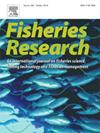“Toki”, a light low-cost video system for seabed research: Performance and precision of Tehuelche scallop (Aequipecten tehuelchus) survey estimates in San José Gulf, Argentina
IF 2.2
2区 农林科学
Q2 FISHERIES
引用次数: 0
Abstract
The monitoring of benthic biomass and biodiversity is essential for fisheries management and environmental impact assessments. In the case of commercial species, such as Tehuelche scallop (Aequipecten tehuelchus), accurate information on stock density and distribution is key for regulating the harvest. The standard survey method used to estimate abundance of Tehuelche scallops in San José Gulf, Argentine Patagonia, based on visual counts obtained by divers, is labor-intensive and limited to diving depths. This study introduces a light low-cost video remote system, named “Toki”, for monitoring scallop beds from small boats. Toki consists of a steel pyramidal structure that houses two cameras, capable of capturing georeferenced high-definition images. The performance of Toki for estimating the density and size composition of scallops was evaluated. The results demonstrate that Toki provides efficient and accurate density estimates, with estimation errors that vary with observer experience and environmental factors such as bottom algal cover. The size frequency distribution obtained from Toki aligned well with that of hand-collected samples, making it possible to obtain size-composition information for beds beyond diveable depths. Toki offers advantages in terms of spatial coverage, simple survey logistics and permanent data records. While there are some limitations, such as processing time for image analysis, future developments based on artificial intelligence may overcome these challenges. Toki has the potential to improve the regular monitoring of scallop beds.
求助全文
约1分钟内获得全文
求助全文
来源期刊

Fisheries Research
农林科学-渔业
CiteScore
4.50
自引率
16.70%
发文量
294
审稿时长
15 weeks
期刊介绍:
This journal provides an international forum for the publication of papers in the areas of fisheries science, fishing technology, fisheries management and relevant socio-economics. The scope covers fisheries in salt, brackish and freshwater systems, and all aspects of associated ecology, environmental aspects of fisheries, and economics. Both theoretical and practical papers are acceptable, including laboratory and field experimental studies relevant to fisheries. Papers on the conservation of exploitable living resources are welcome. Review and Viewpoint articles are also published. As the specified areas inevitably impinge on and interrelate with each other, the approach of the journal is multidisciplinary, and authors are encouraged to emphasise the relevance of their own work to that of other disciplines. The journal is intended for fisheries scientists, biological oceanographers, gear technologists, economists, managers, administrators, policy makers and legislators.
 求助内容:
求助内容: 应助结果提醒方式:
应助结果提醒方式:


